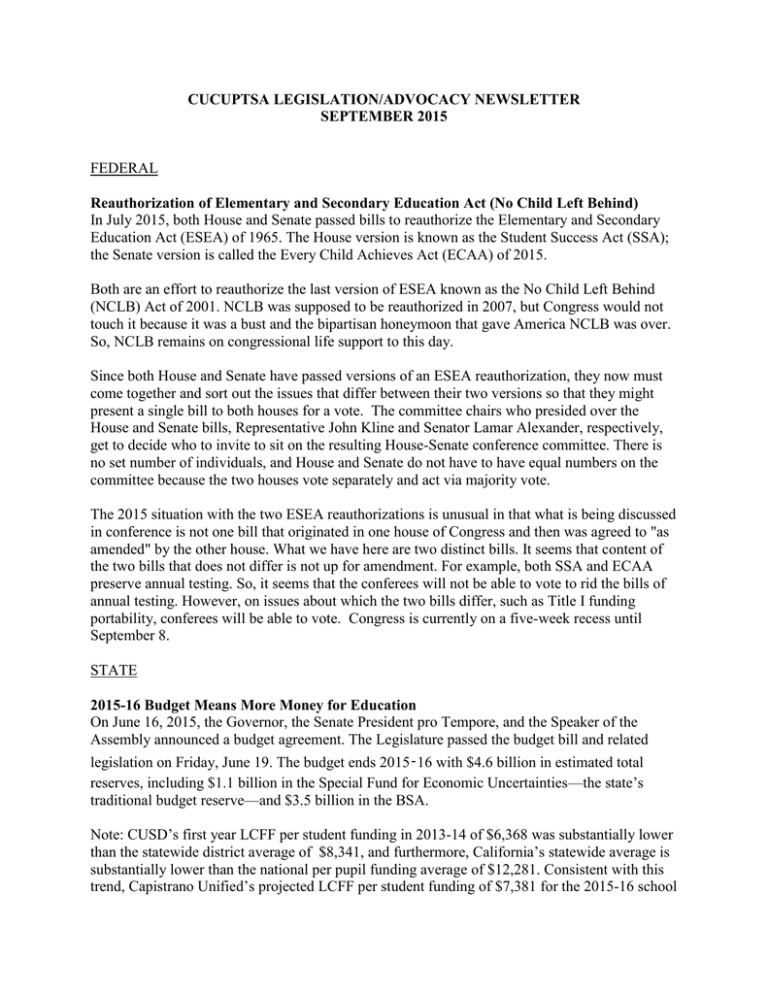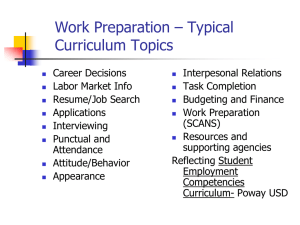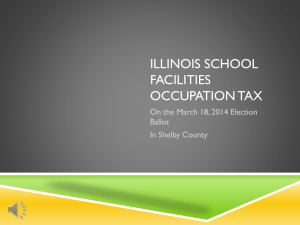September 2015 Advocacy Newsletter
advertisement

CUCUPTSA LEGISLATION/ADVOCACY NEWSLETTER SEPTEMBER 2015 FEDERAL Reauthorization of Elementary and Secondary Education Act (No Child Left Behind) In July 2015, both House and Senate passed bills to reauthorize the Elementary and Secondary Education Act (ESEA) of 1965. The House version is known as the Student Success Act (SSA); the Senate version is called the Every Child Achieves Act (ECAA) of 2015. Both are an effort to reauthorize the last version of ESEA known as the No Child Left Behind (NCLB) Act of 2001. NCLB was supposed to be reauthorized in 2007, but Congress would not touch it because it was a bust and the bipartisan honeymoon that gave America NCLB was over. So, NCLB remains on congressional life support to this day. Since both House and Senate have passed versions of an ESEA reauthorization, they now must come together and sort out the issues that differ between their two versions so that they might present a single bill to both houses for a vote. The committee chairs who presided over the House and Senate bills, Representative John Kline and Senator Lamar Alexander, respectively, get to decide who to invite to sit on the resulting House-Senate conference committee. There is no set number of individuals, and House and Senate do not have to have equal numbers on the committee because the two houses vote separately and act via majority vote. The 2015 situation with the two ESEA reauthorizations is unusual in that what is being discussed in conference is not one bill that originated in one house of Congress and then was agreed to "as amended" by the other house. What we have here are two distinct bills. It seems that content of the two bills that does not differ is not up for amendment. For example, both SSA and ECAA preserve annual testing. So, it seems that the conferees will not be able to vote to rid the bills of annual testing. However, on issues about which the two bills differ, such as Title I funding portability, conferees will be able to vote. Congress is currently on a five-week recess until September 8. STATE 2015-16 Budget Means More Money for Education On June 16, 2015, the Governor, the Senate President pro Tempore, and the Speaker of the Assembly announced a budget agreement. The Legislature passed the budget bill and related legislation on Friday, June 19. The budget ends 2015‑16 with $4.6 billion in estimated total reserves, including $1.1 billion in the Special Fund for Economic Uncertainties—the state’s traditional budget reserve—and $3.5 billion in the BSA. Note: CUSD’s first year LCFF per student funding in 2013-14 of $6,368 was substantially lower than the statewide district average of $8,341, and furthermore, California’s statewide average is substantially lower than the national per pupil funding average of $12,281. Consistent with this trend, Capistrano Unified’s projected LCFF per student funding of $7,381 for the 2015-16 school year is significantly lower than both the state and national averages. With 24% of the district’s students classified as English learners, low income and foster youth, CUSD must divert a significant portion of its budget to support these high-need students, thereby lowering average per student funding even more. As required by trailer legislation enacted last year, the budget package provides $992 million to eliminate all remaining K-14 payment deferrals. The budget year will be the first fiscal year since 2000-01 that the state is set to make all K-14 payments on time. The budget includes an 8% increase to UC and CSU. In 2013-14, the Governor proposed a fouryear funding plan for UC and CSU, that called for (1) base augmentations of 5 percent in 201314 and 2014-15 and 4 percent in 2015-16 and 2016-17, (2) broad discretion for the segments to determine how to spend their state funds, (3) no increases in tuition, and (4) no expectations regarding enrollment. The 2015-16 budget departs from this framework for UC and CSU by providing funding on top of each segment’s 4 percent base augmentation, earmarking some funding for specific purposes, and setting expectations for enrollment growth. Consistent with the Governor’s multiyear plan, the budget assumes no tuition increases for resident students at any of the three segments, though it acknowledges increases in tuition for nonresident students attending UC. UC also plans to increase the Student Services Fee for all students by 5 percent (or $48) in 2015-16. SB277 Becomes Law; Eliminates Personal Exemptions for Vaccinations Bill, which PTA supported, was approved by Governor on June 30, 2015, thereby eliminating the personal belief and religious exemptions that allow parents to opt out of childhood vaccinations required for school enrollment. Only a medical exemption will now excuse a student from being vaccinated as required by state law Why PTA supports bill: In some areas of the state, only 20 percent of kindergartners are fully vaccinated. This low rate puts unvaccinated individuals, including infants and those who are immune-compromised, at risk of contracting potentially fatal contagious diseases, including measles and polio. Some HS Graduates Who Failed Exit Exam May Receive Diplomas The governor on August 26, 2015 signed a bill that eliminates the California High School Exit Exam graduation requirement for seniors in the class of 2015 who didn’t pass it. Senate Bill 725 by Loni Hancock, D--Oakland, was quickly passed by the Assembly last Thursday and by the Senate on Monday as urgency legislation to solve a dilemma that arose when about 5,000 students were denied the opportunity to retake the test in July. The state Department of Education cancelled the exam because its contract with the testing company was expiring and education officials wanted to avoid spending millions of dollars to renew the contract for a test that some believed was outdated, since it was not aligned with the new Common Core standards. Gov. Jerry Brown did not issue a statement about why he signed the bill. But his office issued a statement that said he did not want students’ future plans to be jeopardized. Historical Test Scores Restored in Time for Release of New SBAC Results The California Department of Education began restoring historical test data that it had deleted from the most accessible part of its website earlier this month, following criticism that it did so to discourage the public from making comparisons to the results of new tests aligned to the Common Core standards. The department had taken down 15 years of math and English language arts scores from the database of the Standardized Testing and Reporting program, known as STAR, which enabled the public to search results by district, school and student subgroups from grades 3 through 12. The department plans to release scores from the new tests, known as Smarter Balanced, on Sept. 9. Department o f Education officials and many others have cautioned that comparing results from the two sets of tests would be inappropriate and inaccurate because the academic standards have changed with the adoption of the Common Core, and the new online assessments are very different. Officials initially cited a state law forbidding state agencies and local districts from making test comparisons in justifying the removal of the data. The DOE acknowledged that interpretation was inaccurate; the law did not apply to publicly posting information. LOCAL Board Has Identified Wildly Important Goals (WIGs) for CUSD Moving Forward 1. Teaching and Learning: Engage students in meaningful, challenging, and innovative educational experiences to increase post-secondary options for all students. 2. Communications: Communicate with, and engage students, parents, employees, and community members in district-wide and community-specific decisions. 3. Facilities: Optimize facilities and learning environments for all students. Board Re-evaluating HS Graduation Requirements On July 15, 2015 the Board invited the parents and the community to take part in an interactive workshop as part of process now underway to re-evaluate the district’s high school graduation requirements. Current requirements are being reviewed in light of CUSD’s commitment to college and career readiness and in comparison with other districts in OC. A preliminary PowerPoint presentation (dated 3/25/15), which can be found by searching “high school graduation requirements” on the CUSD website, provides background information on topic. In September, the district will be inviting parents of high school and middle school students, via ListServe, to participate in a survey regarding HS health and CCP semester courses, which are currently required for graduation, and well as potential honors courses for HS. As clarification, the new honors courses approved for the 2015-16 school year—English Honors I & II and Algebra/Trig II—will provide the opportunity for an honors grade point boost by CUSD and many private colleges but not the UC system. The same will be true for new honors courses introduced in 2016-17 or 2017-18. CUSD Recruiting Parent Input on Facilities Plan The Capistrano Unified School District is reviewing its current and future needs for improving and enhancing its school classrooms and campus facilities and invites the public to take part in the discussion and provide input to assist the board in its decision-making process. CUSD has opened the process to all residents, parents, students, business-owners, teachers, retirees and taxpayers within the District boundaries. The discussion will focus on the status and needs of the various campus facilities and school classrooms. The committee will also address school funding challenges, public information and community opinions as well as recommendation to the CUSD Trustees. The Community Committee will meet once a week on Thursdays for four weeks beginning October 15, 2015 and concluding on November 5, 2015. The three-hour meetings will run from 6:00 pm – 9:00 pm and will take place at the District office. Potential volunteers are asked to submit their name, phone number and email address via the district website no later than 5:00 p.m. on September 30, 2015. Facilities Upgrades During the Summer Continue Upgrades are underway at five Capistrano Unified School District campuses. In addition to routine maintenance performed at every campus, the school district is doing additional work at Dana Hills High School, Las Flores Elementary School, Shorecliffs Middle School, Palisades Elementary School and Oxford Preparatory Academy’s Barcelona campus. In addition to the upgrades, Capistrano Unified is making plans to invest $45 million in improvements at Tesoro, San Clemente and San Juan Hills high schools. These improvements are expected to help the schools adapt to local infrastructure and housing development growth – specifically, the expansion of Avenida La Pata, which will create an additional route between San Clemente and San Juan Capistrano, and the Rancho Mission Viejo development. The district expects to add permanent classrooms and parking to San Juan Hills, new classrooms for San Clemente’s lower campus and new portable classrooms at Tesoro, which will also get five new basketball courts. CUSD Considers Full School Site for Community Roots Charter School Community Roots Academy, a K-8 charter school that shares the campus of Wood Canyon Elementary School in Aliso Viejo, has requested the district’s help in finding a larger campus for the start of the 2016-17 school year, per its contract with CUSD from several years ago. At the July 22 meeting, the CUSD board discussed potential school site closures to accommodate the charter school. Two possibilities the board directed staff to examine further are Crown Valley Elementary School in Laguna Niguel and Del Obispo Elementary School. The board informally agreed to rule out closing Wood Canyon, whose parents spoke against /that possibility/ at several board meetings.





